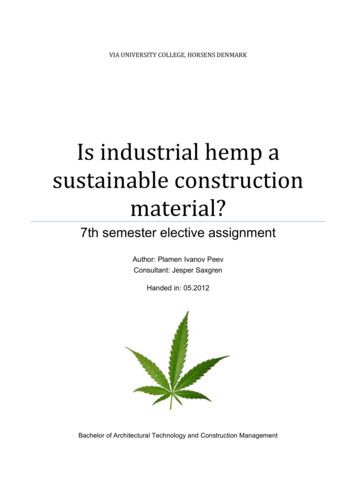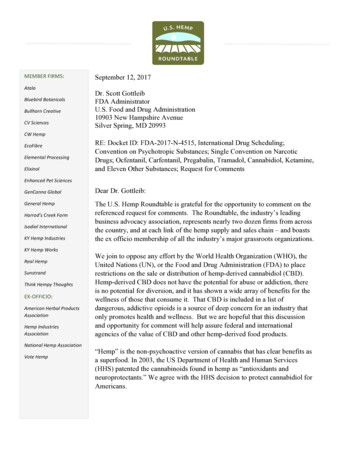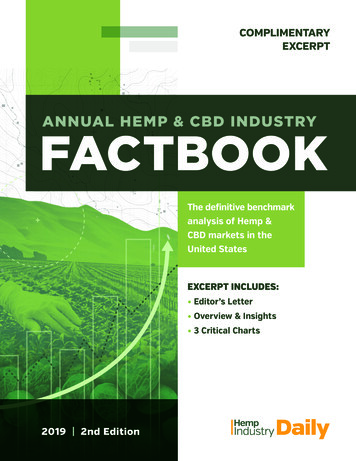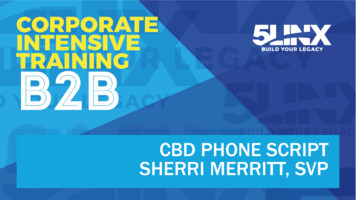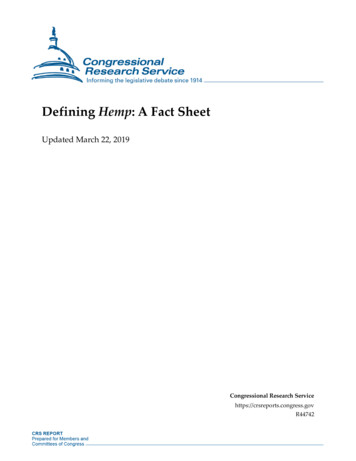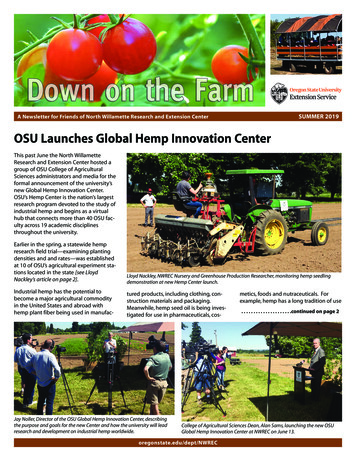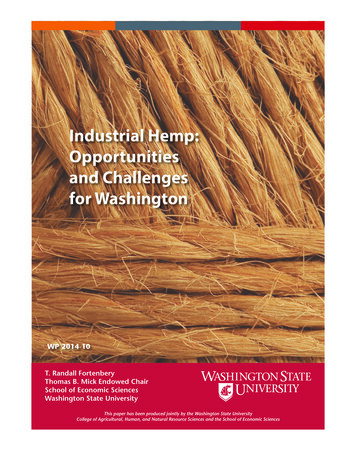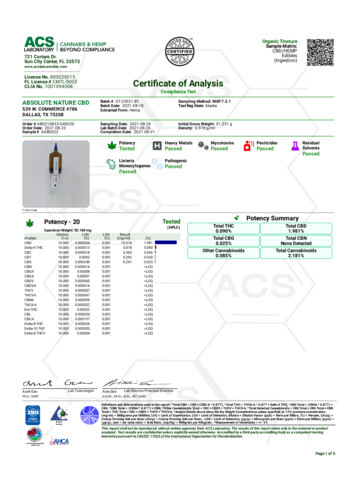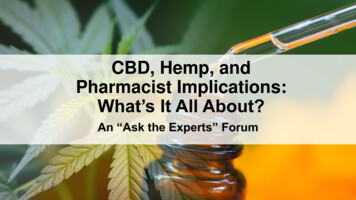
Transcription
CBD, Hemp, andPharmacist Implications:What’s It All About?An “Ask the Experts” Forum
This educational activity is sponsored byPostgraduate Healthcare Education, LLCand supported by an educational grant fromGreenwich Biosciences.
FacultyJacquelyn L. Bainbridge, BSPharm,PharmD, FCCP, MSCS, FAESProfessor, Clinical Pharmacy & Department of NeurologyUniversity of Colorado Anschutz Medical CampusSkaggs School of Pharmacy andPharmaceutical SciencesAurora, ColoradoDr. Jacci Bainbridge received her Doctor of Pharmacy degree from the University of Colorado,where she subsequently completed a specialty residency in neurology. She currently serves as aProfessor at the University of Colorado Anschutz Medical Campus in the Skaggs School of Pharmacyand Pharmaceutical Sciences and the Department of Clinical Pharmacy, as well as the Department ofNeurology in the School of Medicine. Dr. Bainbridge is an Investigator on several federal and statefunded clinical research trials in neurology and cannabis. She is a frequent lecturer on topics ofneurological and pharmacological interest in the areas of restless legs syndrome, multiple sclerosis,epilepsy, migraine, neuroprotection, chronic pain disorders, cannabis, and movement disorders.
FacultyLaura Borgelt, PharmD, MBA, FCCP, BCPSProfessor and Associate Vice Chancellor of Strategic InitiativesDepartments of Clinical Pharmacy and Family MedicineSkaggs School of Pharmacy and Pharmaceutical SciencesUniversity of Colorado Anschutz Medical CampusAurora, ColoradoDr. Laura Borgelt is an Associate Vice Chancellor of Strategic Initiatives at the University ofColorado Anschutz Medical Campus and a Professor at the Skaggs School of Pharmacy and theDepartments of Clinical Pharmacy and Family Medicine. For the past 10 years, she has investigatedthe potential effectiveness and risks of cannabis in a comprehensive manner and has providedevidence-based presentations to medical, nursing, pharmacy, and patient organizations at the stateand national levels. She has served on 8 different working groups regarding rulemaking forconsumer safety and social issues in the state of Colorado.
DisclosuresDr. Bainbridge has disclosed that she has received grant/research support fromGreenwich Biosciences.Dr. Borgelt has disclosed that she has no actual or potential conflicts of interest inrelation to this program.The clinical/legal reviewer, Gerald Gianutsos, JD, PhD, has no actual or potentialconflicts of interest in relation to this program.Susanne Batesko, BSN, RN, Robin Soboti, RPh, and Susan R. Grady, MSN, RN, aswell as the planners, managers, and other individuals, not previously disclosed, whoare in a position to control the content of Postgraduate Healthcare Education, LLC(PHE) continuing education activities, hereby state that they have no relevant conflictsof interest and no financial relationships or relationships to products or devices duringthe past 12 months to disclose in relation to this activity. PHE is committed to providingparticipants with a quality learning experience and to improve clinical outcomes withoutpromoting the financial interests of a proprietary business.
AccreditationPostgraduate Healthcare Education, LLC isaccredited by the Accreditation Council forPharmacy Education as a provider of continuingpharmacy education.UAN: 0430-0000-21-001-H03-PCredits: 1.5 hours (0.15 CEUs)Type of Activity: Application
Learning Objectives Assess the most up-to-date data about medical marijuanaand cannabidiol (CBD)–containing agents, including bothover-the-counter products and agents approved as prescriptionagents by the US Food and Drug Administration Assess CBD, tetrahydrocannabinol (THC), and other cannabinoidcontaining products including issues relating to purity, consistency,formulation, and dose Describe the differences among cannabis products in medicalor recreational dispensaries compared with street products orhome-grown, plant-based substances Discuss current laws related to cannabis-derived agents andproducts in the US
Outline for Presentation Overview: CBD and Medical Marijuanaor Cannabis CBD in Neurologic and Psychiatric Disorders Legal Implications Conclusions and Additional Q&A
OVERVIEW:CBD AND MEDICALMARIJUANA OR CANNABIS
Cannabis Contains over 400 compounds Over 100 cannabinoids have been isolated Terpenes are variable, contribute to aroma (limonene, pinene), andserve as a precursor to cannabinoids Cannabinoids and terpenes are found in:flowering tops buds top leaves lower leaves stems stalks Indica and sativa have been crossbred, so there are no generalizablecharacteristics The first documented date of cannabis use for medicinal purposeswas in 400 AD Cannabis was mentioned in the USP in 1850USP, United States Pharmacopeia.Borgelt LM, et al. Pharmacotherapy. 2013;33(2):195-209.
Delta-9-tetrahydrocannabinol (THC) Major component of cannabis that causes the “high” or “euphoric” feeling Mechanism of action: partial CB1 agonist Beneficial effects Helps prevent nausea/vomiting due to cancer chemotherapy Appetite promoter Some medical conditions Short-term adverse effects Memory loss, loss of time, impaired coordination, increased heart rate & variability Altered thinking, panic, delusions/hallucinations, paranoia, psychosis Long-term adverse effects Addiction (9% overall), altered brain development*, diminished life satisfactionand achievement*, cognitive impairment (lower IQ)*, hyperemesis syndrome,symptoms of chronic bronchitis, increased risk of chronic psychosis disorders,poor educational outcome*Strongly associated with initial marijuana use early in adolescence.Volkow ND, et al. N Engl J Med. 2014;370(23):2219-2227.
Cannabidiol (CBD) Major noneuphoric component of cannabis (no high) Precise mechanism of action is unknown; may be an antagonistor an inverse agonist Indirect effect on the CB1 receptor, via anandamide (2AG) andother endocannabinoids Endocannabinoids bind to CB1 and CB2 receptors CB1 receptors are found primarily in the central and peripheralnervous systems and CB2 receptors are found primarily in theimmune system and peripheral tissues Research into other receptors (eg, opioid, G-protein receptors,G-protein–coupled receptors [GPR55]) is ongoingBorgelt LM, et al. Pharmacotherapy. 2013;33(2):195-209. Devinsky O, et al. Epilepsia. 2014;55(6):791-802.Devinsky O, et al. Lancet Neurol. 2016;15(3):270-278. Grotenhermen F. Clin Pharmacokinet. 2003;42(4):327-360.
Cannabidiol (CBD) (continued) Beneficial effects No significant neurologic effects No effects on vital signs or mood Can increase sedation Enhances the activity of the endogenous cannabinoid(anandamide) Adverse effects Somnolence, decreased appetite, diarrhea, fatigue, increasedliver function tests, convulsion May increase risk of infectionBorgelt LM, et al. Pharmacotherapy. 2013;33(2):195-209. Devinsky O, et al. Epilepsia. 2014;55(6):791-802.Devinsky O, et al. Lancet Neurol. 2016;15(3):270-278. Grotenhermen F. Clin Pharmacokinet. 2003;42(4):327-360.
Industrialized Hemp Federal law defines industrialized hemp as “a plant of the genuscannabis and any part of the plant, whether growing or not,containing a delta-9-tetrahydrocannabinol (THC) concentrationof no more than 0.3% on a dry weight basis” Must be a registered industrial hemp farmer with the USDA Marijuana must be grown inside with regulated light, temperature,humidity, CO2, and O2 levels Maximize THC concentration Hemp must be grown outdoors to maximize size and yield Less attention paid to individual plantsUSDA, United States Department of Agriculture. https://nifa.usda.gov/industrial-hemp.
Differences Between Hemp and MarijuanaHempMarijuanaStatutory definition“the plant Cannabis sativa L.and any part of that plant.whether growing or not, with adelta-9-tetrahydrocannabinolconcentration of not more than0.3 percent on a dry weight basis”1“all parts of the plant Cannabis sativa L., whether growingor not; the seeds thereof; the resin extracted from anypart of such plant; and every compound, manufacture,salt, derivative, mixture or preparation of such plant, itsseeds or resin.”2 Does not include: Mature stalks Fiber, oil, or cake from the seed Sterilized seed incapable of ychotropicThreshold forpsychoactivecompoundsNo more than 0.3% delta-9-THC on adry weight basisNo THC threshold specifiedPrimary federalagencies withregulatory oversightUSDAFDADEAFDADEA, US Drug Enforcement Administration.1. 2018 Farm Bill. PL 115-334, §10113. 2. Federal Food, Drug, and Cosmetic Act. 21 USC §802(16).
FDA-Approved ProductsMarinol /Syndros (dronabinol) FDA approved in 1985Synthetic THCSchedule IIIUsed for: Anorexia in patients with AIDS Nausea and vomiting associated with cancer chemotherapyEpidiolex (cannabidiol) FDA approved in June 2018Plant-derived CBDThe first FDA-approved cannabinoid prescription drugUsed for: Lennox-Gastaut syndrome Dravet syndrome Tuberous sclerosis complexEpidiolex (cannabidiol) [package insert]. Carlsbad, CA: Greenwich Biosciences, Inc; 2018.Marinol (dronabinol) [package insert]. North Chicago, IL: AbbVie Inc; 2017.Syndros (dronabinol) [package insert]. Chandler, AZ: Insys Therapeutics, Inc; 2016.
Other ProductsCesamet (Nabilone) FDA approved in 2006Synthetic cannabinoidSchedule IIUsed for: Nausea and vomiting for cancer-related chemotherapySativex (THC and CBD) Licensed for use in the United KingdomNot FDA approvedUsed for: Multiple sclerosis–related spasticityCesamet (nabilone) [package insert]. Costa Mesa, CA: Valeant Phamaceuticals; 2006.Sativex (THC and CBD) [package insert]. Cambridge, UK: GW Pharmaceuticals; 2016.
Cannabis Activity at CB1 ReceptorsStructureTHC effectCBD EffectNeocortexAltered thinking, judgementDelayed onset time to intoxication with THCBasal gangliaSlowed reaction timeReduced psychomotor abnormalities from THCHypothalamus appetiteAmygdalaPanic, paranoiaDecreased THC-induced anxietyNucleus accumbensEuphoriaAttenuated THC-induced euphoriaHippocampusImpaired memoryAttenuated THC-induced memory effectsCerebellumImpaired coordinationReduced coordination abnormalities from THCBrain stemAnti-nausea effectsHippocampus, forebrainAnti-epileptic effects?Spinal cordAltered pain sensitivity1992No to little effect on appetite1985Antiepileptic effects for certain populations1996TRPV reduction in painDose-response effects of CBD not established Low dose 300 mg inconsistent effectsTypical response can be seen at 600 mg
Trends in Cannabis UseTrends in Prevalence of Marijuana Use, 5.4%12.5%13.3%10.0%6.7%8.6%0.0%LifetimePast YearAges 12-17 yearsAges 18-25 yearsPast MonthAges 26 years or olderNational Survey on Drug Use and Health. https://www.drugabuse.gov/drugs-abuse/marijuana.
Cannabis Use in the United States Medical cannabis use (Mahabir 2020) Average age 45.5 years 54.8% were male and the majority were Caucasian (87.5%) 67% of patients reported cannabis experience prior to seekingmedical certification Primary medical conditions: chronic pain, anxiety, and PTSD Average number of comorbid conditions reported was 2.7 14% of Americans say they use CBD products (2019) 40% for pain 20% for anxiety 11% for sleepPTSD, posttraumatic stress disorder.Gallup. cbd-products.aspx.Mahabir VK, et al. J Cannabis Res. 2020;2(1):32.
Summary Cannabis is a complex plant with over 100 cannabinoids;THC and CBD remain the most well-known The importance of understanding the differencesbetween cannabis-based products is important forpatient care Rigorous research needs to be conducted to trulydecide which medical conditions can best be treatedwith cannabis
Questions & Answers
Medical Benefits of CBD Epidiolex Lennox-Gastaut syndrome Dravet syndrome Tuberous sclerosis complex Other CBD products No FDA-approved indications Growing number of studies for other conditions
Cannabidiol (Epidiolex): Dravet SyndromeSeizure Frequency45Difference: -19.2%(-39.3 to -1.2; P .03)Median no. seizures/month4035302541.5-9.0%Difference: -22.8%(-41.1 to -5.4; P .01)31.12420-13.3%1510Adverse Effects 93% of cannabidiol 75% of : 84% mild/moderate Vomiting, fatigue,pyrexia, upperrespiratory tractinfection, appetite,convulsion, lethargy,somnolence, anddiarrhea 8 withdrew from trial0CannabidiolPlaceboConvulsive SeizuresCannabidiolTotal SeizuresBaselinePlaceboPlacebo: 95% mild/moderate 1 withdrew from trialTreatment periodDevinsky O. N Engl J Med. 2017;376(21):2011-2020.
Cannabidiol (Epidiolex): Lennox-GastautSeizure Frequency200Difference: -21.1(-33.3 to -9.4; P .005)180Median no. seizures/month176.7Adverse effects 86% of cannabidiol 69% of placebo160140120100128.7Difference: -17.21(-30.32 to -4.09; P 21.8%56.331.40CannabidiolPlaceboCannabidiolDrop SeizuresPlaceboCannabidiol: 78% mild/moderate Diarrhea, somnolence,pyrexia, appetite,vomiting 14 withdrewPlacebo: 97% mild/moderate 1 withdrewTotal SeizuresBaselineTreatment periodDevinsky O. N Engl J Med. 2017;376(21):2011-2020.
Other Conditions: Evidence With CBDConditionTypes of Evidence Breast cancer Anxiety Depression Osteoarthritis Meta-analysisSystematic reviewRandomized controlled trial (RCT)Prospective observational studyRetrospective observational studyCase-control studyCase seriesCase reportPreclinical or animal studies
CBD and Breast CancerMol Cancer Ther.2011;10(7):1161-1172.“Our study revealed an intricateinterplay between apoptosis andautophagy in CBD-treated breastcancer cells and highlighted thevalue of continued investigationinto the potential use of CBD asan antineoplastic agent.”Breast. 2018;41:34-41.“The results suggest that CBDtreatment induces an interplayamong PPARγ, mTOR andcyclin D1 in favor of apoptosisinduction in both ER-positiveand triple negative breastcancer cells, proposing CBD asa useful treatment for differentbreast cancer subtypes.”Preclinical evidence or animal studies
CBD and Anxiety: Systematic Review 8 articles: 6 small RCTs, 1 case series, and 1 case report Role of CBD in the anxiety response of healthy volunteers Generalized anxiety disorder, social anxiety disorder, anxiety component of PTSD CBD administration Orally as capsule or sublingual spray and as either monotherapy or adjunctive therapy Doses varied widely with fixed doses of 6 mg to 400 mg per dose Results CBD demonstrated improved clinical outcomes among anxiety assessment scales CBD was well-tolerated and associated with minimal adverse effects, with the mostcommonly noted adverse effects being fatigue and sedationMixed evidence, small sample sizes, variety of dosing andadministration, lack standardized assessment toolSkelley JW, et al. J Am Pharm Assoc. 2020;60(1):253-261.
CBD and DepressionCNS Neurol Disord Drug Targets.Mol “Studies involving animal models,“These results indicate that CBDperforming a variety ofinduces fast and sustainedexperiments suggest that CBDantidepressant-like effect inexhibited an anti-anxiety anddistinct animal models relevantantidepressant effects Most of the for depression The data supportstudies demonstrated a gooda promising therapeutic profile forinteraction between CBD and theCBD as a new fast-acting5-HT1A neuro-receptor.”antidepressant drug.”Preclinical evidence or animal studies
CBD and Osteoarthritis Male Wistar ratswith kneeosteoarthritis CBD 100-300 mcgapplied topically orvehiclePreclinical evidence or animal studiesPhilpott HT, et al. Pain. 2017;158(12):2442-2451. Mlost J. Int J Mol Sci. 2020;21(22):8870.
Purity and Potency of CBD Products“FDA is aware that some companies are marketingproducts containing cannabis and cannabis-derivedcompounds in ways that violate the Federal Food,Drug and Cosmetic Act (FD&C Act) and that may putthe health and safety of consumers at risk.The agency is committed to protecting the publichealth while also taking steps to improve theefficiency of regulatory pathways for the lawfulmarketing of appropriate cannabis andcannabis-derived -derived-products-including-cannabidiol-cbd.
Inaccurate Labeling of CBD Products84 CBD PRODUCTS TESTED FOR LABEL ACCURACYUNDERLABELEDOVERLABELED(CBD content(CBD content belowexceeded label value)labeled value)36 (42.9%)22 (26.2%)ACCURATE(CBD content within10% of labeled value)26 (31.0%)THC was detected in 18 of the 84 samples testedBonn-Miller MO, et al. JAMA. abis-or-cannabis.
Potential for Contamination FDA and EPA have not provided guidance on how toregulate contaminants or on cannabis-related exposuresthat can be considered safe States have had to determine this on their own Chemical solvents Microbial contamination Pesticides and insecticides Metal contamination Cannabis is known to be a i/full/10.1289/EHP5785.
Ensuring Quality of CBD Products Third-party testing (certificate of analysis) Potency; how much CBD? THC? Total? Contaminants, solvents, pesticides, microbiological tests CO2-extracted products GMP-certified Certified organic Choosing brands Following best practicesReliable source of hempSustainable businessSupport team to answer questions Note: Hemp seed oil is not CBD Avoid products with health claims
Third-PartyTesting
FDA Warnings: CBD Products (Dec 2020) FDA issued 5 warning letters to companies for selling productscontaining CBD in ways that violate the FD&C Act All 5 warning letters address the illegal marketing of unapprovedCBD products claiming to treat medical conditions CBD products that are concerning from a public health perspectivedue to route of administration, including nasal, ophthalmic, andinhalation Address violations relating to the addition of CBD to food, and theimpermissible marketing of CBD products as dietary supplements Two of the letters also address CBD products illegally marketed forpets, including a product for use in the ducts.
juana-consumption-styles/.
Dosing: Cannabidiol (Epidiolex) Cannabidiol (Epidiolex): oral solution 100 mg/mL Lennox-Gastaut and Dravet syndromes Starting dose is 2.5 mg/kg by mouth twice daily (5 mg/kg/day) After 1 week, the dosage can be increased to a maintenancedosage of 5 mg/kg twice daily Tuberous sclerosis Starting dose is 2.5 mg/kg by mouth twice daily (5 mg/kg/day) Increase dosage weekly by 2.5 mg/kg twice daily (5 mg/kg/day),as tolerated, to a recommended maintenance dosage of 12.5mg/kg twice daily (25 mg/kg/day)McCallum CA, et al. Eur J Intern Med. 2018;49:14-19.Millar SA. Br J Clin Pharmacol. 2019;85(9):1888-1900.Zuurman L. Br J Clin Pharmacol. 2009;67(1):5-21.
Dosing: Other Medical Cannabis Products Doses vary in form and usage Cannot confirm safe, beneficial dosages outside approved dosages Systematic review of CBD dosing 35 studies of CBD dosing in 13 medical contexts Dosing range 1 to 50 mg/kg/day Typical “effective” dosing of inhaled THC Low dose 7 mg Medium dose 7–18 mg High dose 18 mg “Start low, go slow, and stay low”McCallum CA, et al. Eur J Intern Med. 2018;49:14-19.Millar SA. Br J Clin Pharmacol. 2019;85(9):1888-1900.Zuurman L. Br J Clin Pharmacol. 2009;67(1):5-21.
SummaryPrescription Cannabis-BasedProducts Rigorous regulatory process Rigorous clinical trials Evidence they work fortherapeutic indications Ingredients are known andconsistent Standardized dose andformulationOTC Cannabis-BasedProducts No clinical trials No specific indications andcompanies should not includeany health claims on the label Ingredients may be knownand may be consistent(or may not be) Variable dosing and manydifferent formulations
Questions & Answers
CBD IN NEUROLOGIC ANDPSYCHIATRIC DISORDERS
CBD Effects on Seizure Activity Studies have demonstrated endogenous cannabinoid systemsare altered in a variety of models of seizures and epilepsy External modulation can prevent/modulate seizure activity CBD antiseizure activity considered to be mediated bymechanisms other than CB1/2 agonism 10 proposed targets THC antiseizure activity mediated by partial agonism ofCB1 receptor Inconsistent activity demonstrated Psychotropic effects make it undesirable for treatmentin epilepsyPerucca E. J Epilepsy Res. 2017;7(2):61-76.
Dravet Syndrome (DS) Rare genetic infantile epileptic encephalopathy Frequent and prolonged seizures status epilepticus Poor motor, interpersonal, and language skills; hyperactivity Autonomic dysfunction, sleep problems Due to SCN1A mutation (in the sodium channel) or other mutations Present in 85% of children with DS1-4 Not inherited from the parents A blood test may confirm diagnosis Incidence in US is approximately 1 in 20,0005-8 to 1 in 40,0009 Treatment includes valproate, clobazam, stiripentol, fenfluramine,ketogenic diet, vagus nerve stimulation (VNS), cannabidiol(Epidiolex)1. Escayg A, et al. Epilepsia. 2010;51(9):1650-1658. 2. Fukuma G, et al. Epilepsia. 2004;45(2):140-148. 3. Wang JW, et al. Epilepsia. 2008;49(9):1528-1534.4. Zuberi SM, et al. Neurology. 2011;76(7):594-560. 5. Wu YW, et al. Pediatrics. 2015;136(5):e1310-e1315. 6. Brunklaus A, et al. Epilepsia. 2011;52(8):1476-1482.7. Rogona F, et al. Brain Dev. 2010;32(1):71-77. 8. Ragona F, et al. Epilepsia. 2011;52(2):386-392. 9. Knupp KG, et al. CNS Drugs. 2018;32(4):335-350.
Lennox-Gastaut Syndrome (LGS) The causes of LGS can be divided into 2 categories Symptomatic: brain injury, generally diffuse injuries (encephalitis,meningitis, tuberous sclerosis complex, brain malformations, hypoxiaat birth, trauma) to the frontal lobes of brain Identifiable cause; 75% have this type Cryptogenic: no clear cause; may be associated with mutations orchanges on parts of the genes that could contribute to thedevelopment of LGS Most seizures associated with LGS typically occur at age 3 years(between 1 and 7 years); 5 times more common in boys1-4 Incidence is approximately 2.8 per 100,000 live births5 Represents 4% to 10% of all childhood epilepsies4-71. Epilepsy Foundation. yndrome-overview. 2. Gastaut H, et al.Epilepsia. 1966;7(2):139-179. 3. Arzimanoglou A, et al. Epileptic Disord. 2011;13(suppl 1):S3-S13. 4. Panayiotopoulos CP. ILAE classification and practice parameterguidelines; 2010. 5. Rantala H, et al. Epilepsia. 1999;40(3):286-289. 6. Gastaut H, et al. Epilepsia. 1975;16(3):457-461. 7. Trevathan E, et al. Epilepsia. 1997;38(12):1283-1288.
Treatment of LGS Ketogenic diet—may be helpful Vagus nerve stimulation (VNS)—may be helpful Responsive neurostimulation—may be helpful Corpus callosum surgery—may decrease the number of seizures Cannabidiol, CBD (Epidiolex)—approved June 2018 Clobazam (Onfi) Lamotrigine (Lamictal) Topiramate (Topamax) Felbamate (Felbatol) Rufinamide (Banzel)Epilepsy Foundation . yndrome-overview.
Tuberous Sclerosis Complex (TSC) Autosomal dominant (1 mutated gene) genetic condition that can involvemultiple organ systems, including the heart, brain, kidneys, lungs, eyes,and skin (ash-leaf spots) Mutations in 1 of 2 genes (TSC1 and TSC2) in 70% of cases 1/3 of cases are inherited from parents, while 2/3 occur spontaneously Occurs in 1 out of 6000 people Diagnosis based on specific clinical criteria and/or genetic testing Epilepsy present in 90% of TSC patients and may become intractable toautism spectrum disorders (ASDs) Autism develops in 25% to 50% of patients with TSC Seizures—infantile spasms, focal, tonic, clonic, atonic, absence Treatment—infantile spasms (vigabatrin), other ASDs, ketogenic diet,VNS, surgery, sirolimus, everolimus (giant cell astrocytomas)Epilepsy.com 8/18/2020
Cannabidiol (Epidiolex) First FDA-approved cannabinoid prescription drug from plantmaterial that is different from other CBD products Indication: Treatment of LGS, DS, and TSC DEA schedule: Now descheduled (was schedule V) Dosage form: Oral solution (100 mg/mL) Contains: 0.1% THC in the API powder and 0.01% THC in thefinished oral solution Side effects (10%): Somnolence, decreased appetite, diarrhea, transaminase elevations,fatigue, malaise, asthenia, rash, insomnia, sleep disorder, poor qualitysleep, infectionsAPI, Active Pharmaceutical Ingredient.Epidiolex (cannabidiol) [package insert]. Carlsbad, CA: Greenwich Biosciences, Inc.; 2018.Gaston TE, et al. Epilepsia. 2017;58(9):1586-1592.
Epidiolex: Mechanism of Action The precise mechanisms by which Epidiolex exerts itsanticonvulsant effect in humans are unknown Cannabidiol does not appear to exert its anticonvulsant effectsthrough interaction with cannabinoid receptors Cannabidiol potentially: Blocks GPR55 receptors Desensitizes TRPV1 channels Inhibits adenosine reuptake pumps Decreasing calcium and increasing extracellular adenosine Decreasing neuroexcitabilityEpidiolex (cannabidiol) [package insert]. Carlsbad, CA; Greenwich Biosciences, Inc.; 2020.
Epidiolex: cretionTmax 2.5-5 hHigh-fat/high-calorie meal Cmax 5-fold, AUC 4-foldProtein bound 94%t1/2 56-61 hLiver (CYP2C19, CYP3A4, UGT1A7,UGT1A9, UGT2B7)7-OH-CBD metabolite is activeFeces, minor renal clearanceEpidiolex (cannabidiol) [package insert]. Carlsbad, CA; Greenwich Biosciences, Inc.; 2020.
Epidiolex: Dosing Strategiesfor LGS and DS When discontinuing, dose decreased gradually to minimize risk ofincreased seizure frequency or status epilepticusEpidiolex (cannabidiol) [package insert]. Carlsbad, CA; Greenwich Biosciences, Inc.; 2020.
Epidiolex: Dosing Strategies for TSC Starting dose is 2.5 mg/kg twice daily (5 mg/kg/day) Increase the dose in weekly increments of 2.5 mg/kgtwice daily (5 mg/kg/day) Recommended maintenance dosage of 12.5 mg twicedaily (25 mg/kg/day) For patients in whom a more rapid titration to 25 mg/kg/dayis needed, the dosage may be increased no morefrequently than every other dayEpidiolex (cannabidiol) [package insert]. Carlsbad, CA; Greenwich Biosciences, Inc.; 2020.
Epidiolex: Warnings Epidiolex causes dose-related elevations of ALT and AST In 2/3 of cases, discontinuation or reduction of Epidiolex resolvedtransaminase elevations In 1/3 of cases, elevations resolved without dose reduction of Epidiolex Dose adjustment recommended in patients with moderate(Child-Pugh B) or severe (Child-Pugh C) hepatic impairment Slower dose titration may be necessary Increased incidence of liver enzyme elevations with valproateadministration Epidiolex meets highest standards for safety and quality, unlikeother medical marijuana productsALT, alanine aminotransferase; AST, aspartate aminotransferase.Epidiolex (cannabidiol) [package insert]. Carlsbad, CA: Greenwich Biosciences, Inc.; 2018.Gaston TE, et al. Epilepsia. 2017;58(9):1586-1592.
Epidiolex: Drug-Drug Interactions Epidiolex metabolized by CYP3A4 and CYP2C19 Coadministration with moderate to strong inhibitors willincrease Epidiolex concentration 3A4 inhibitors—diltiazem, verapamil, ketoconazole, itraconazole,erythromycin 2C19 inhibitors—fluvoxamine, isoniazid, ritonavir Coadministration with strong inducers will decreaseEpidiolex concentration 3A4 inducers—carbamazepine, St. John's wort, phenobarbital,phenytoin, rifampin 2C19 inducers—carbamazepine, phenytoin, rifampinCYP, cytochrome P450.
Drug-Drug Interactions (continued) Epidiolex* clobazam Produces 3-fold increase in plasma concentrations of activemetabolite of clobazam (substrate of CYP2C19) Epidiolex valproate Concomitant use increases the incidence of liver enzymeelevation Epidiolex* rufinamide or topiramate or eslicarbazepine Increased serum concentration of rufinamide or topiramate oreslicarbazepineEpidiolex (cannabidiol) [package insert]. Carlsbad, CA: Greenwich Biosciences, Inc.; 2018.*Gaston TE, et al. Epilepsia. 2017;58(9):1586-1592.
Epidiolex: Counseling and Monitoring Monitor liver function tests (LFTs) at baseline and at 1, 3, and 6 monthsafter initiation and periodically thereafter, as clinically indicated Can cause weight loss, a decrease in hematocrit and hemoglobin, andelevations in serum creatinine Screen for drug interactions and contraindications Store at room temperature and discard after 12 weeks of opening Pregnancy precaution Do not discontinue abruptly Causes sedation (use caution when operating hazardous machinery) May cause a positive drug screen for cannabis since it contains 0.1%THC in the API powder and 0.01% in the finished productEpidiolex (cannabidiol) [package insert]. Carlsbad, CA: Greenwich Biosciences, Inc.; 2018.Gaston TE, et al. Epilepsia. 2017;58(9):1586-1592.
What Is the Future? Additional cannabis-based formulations in clinical trialsand approved in other countries (Sativex) Use of Epidiolex for treatment-resistant epilepsy(currently off-label use) Quality of OTC products is needed prior to makingappropriate dosing recommendations and medicalclaims Clinical trials and additional research
The Contribution of Various Cannabis Use to Variationin the Incidence of Psychotic Disorder Across Europe(EU-GEI): A Multicentre Case–Con
Departments of Clinical Pharmacy and Family Medicine. For the past 10 years, she has investigated the potential effectiveness and risks of cannabis in a comprehensive manner and has provided evidence-based presentations to medical, nursing, pharmacy, and patient organizations at the state and national levels.
